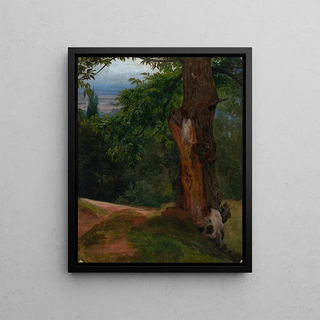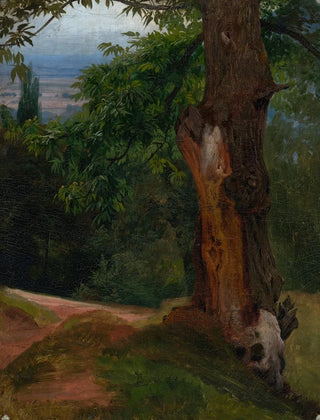Art print | Tree study with view of the valley - Johann Wilhelm Schirmer


View from behind

Frame (optional)
In the world of art, some works manage to capture the very essence of nature while evoking deep reflection on the beauty of the landscape. "Art print of a tree study with a view of the valley - Johann Wilhelm Schirmer" is one of those creations that invites the viewer to immerse themselves in a universe where nature and art meet harmoniously. This painting, both simple and complex, reveals the subtleties of a landscape that seems alive, vibrant under the artist's brushstrokes. Contemplating this piece, one feels an invitation to explore not only the depicted valley but also the emotions it evokes, like a gentle melody resonating in the soul.
Style and uniqueness of the work
Johann Wilhelm Schirmer's work stands out for its delicate and poetic approach to the landscape. In "Art print of a tree study with a view of the valley," every detail is carefully considered, from the foliage to the nuances of light dancing on the ground. Schirmer's style is characterized by a subtle color palette, where deep greens blend with touches of golden light, creating a striking contrast between shadow and clarity. This mastery of light, combined with meticulous attention to textures, gives the piece a depth that invites exploration. The tree, majestic and rooted in the ground, seems to be the guardian of the valley, while the panorama extending beyond calls for contemplation. Each brushstroke reveals not only natural beauty but also an inner harmony that transcends the simple landscape.
The artist and his influence
Johann Wilhelm Schirmer, an emblematic figure of the 19th century, marked his era with his unique vision of the landscape. Raised in a rich artistic context, he absorbed Romantic influences while developing his own style. His passion for nature, fueled by his travels across Europe, was the driving force behind his creations. Schirmer did not merely reproduce landscapes; he sought to express feelings, to capture the ephemeral, and to immortalize moments of beauty. His work not only influenced his

Matte finish

View from behind

Frame (optional)
In the world of art, some works manage to capture the very essence of nature while evoking deep reflection on the beauty of the landscape. "Art print of a tree study with a view of the valley - Johann Wilhelm Schirmer" is one of those creations that invites the viewer to immerse themselves in a universe where nature and art meet harmoniously. This painting, both simple and complex, reveals the subtleties of a landscape that seems alive, vibrant under the artist's brushstrokes. Contemplating this piece, one feels an invitation to explore not only the depicted valley but also the emotions it evokes, like a gentle melody resonating in the soul.
Style and uniqueness of the work
Johann Wilhelm Schirmer's work stands out for its delicate and poetic approach to the landscape. In "Art print of a tree study with a view of the valley," every detail is carefully considered, from the foliage to the nuances of light dancing on the ground. Schirmer's style is characterized by a subtle color palette, where deep greens blend with touches of golden light, creating a striking contrast between shadow and clarity. This mastery of light, combined with meticulous attention to textures, gives the piece a depth that invites exploration. The tree, majestic and rooted in the ground, seems to be the guardian of the valley, while the panorama extending beyond calls for contemplation. Each brushstroke reveals not only natural beauty but also an inner harmony that transcends the simple landscape.
The artist and his influence
Johann Wilhelm Schirmer, an emblematic figure of the 19th century, marked his era with his unique vision of the landscape. Raised in a rich artistic context, he absorbed Romantic influences while developing his own style. His passion for nature, fueled by his travels across Europe, was the driving force behind his creations. Schirmer did not merely reproduce landscapes; he sought to express feelings, to capture the ephemeral, and to immortalize moments of beauty. His work not only influenced his






